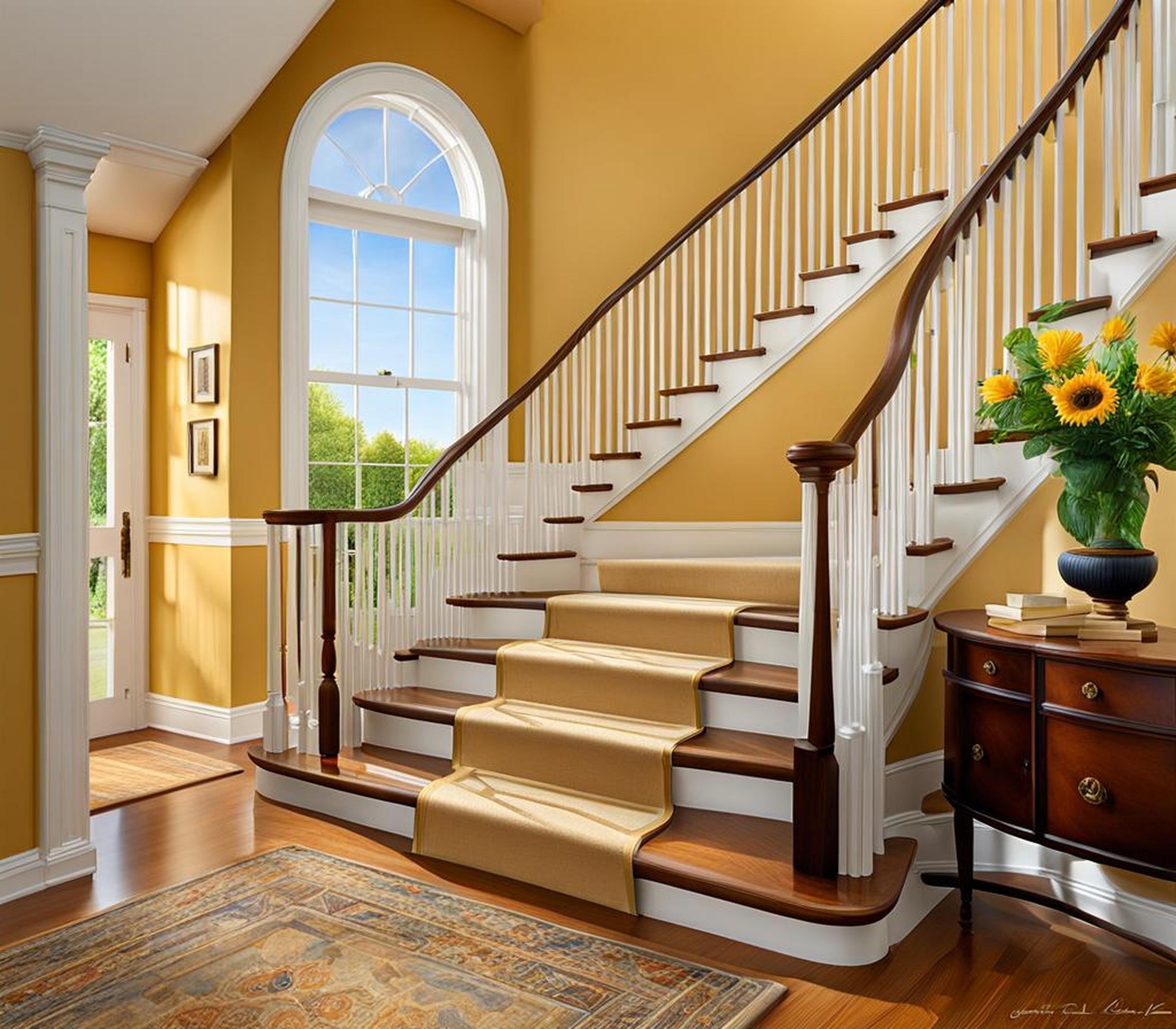Painting indoor stairs can be a tricky task. As a high-traffic area, indoor stairs take a beating and require paint that can stand up to constant use without looking worn down. The right paint should not only be durable and long-lasting, but also provide enough traction to avoid slips and falls.
Follow these four simple steps to choose a paint that checks all the right boxes for aesthetics, performance, and safety.
Step 1: Consider Paint Finish
The first decision to make is which paint finish, or sheen level, works best for stairs. Finish impacts the look, durability, and slip-resistance of the paint.
Gloss and Sheen Levels
Paint finishes range from matte to high gloss. Matte paint has a flat, non-reflective look. On the other end of the spectrum, high-gloss paint has a shiny, mirror-like surface. In between those two extremes are options like eggshell, satin, and semi-gloss.
Here’s an overview of the common paint sheens to consider for indoor stairs:

- Matte: Completely non-reflective flat finish. Prone to scuffing and stains.
- Eggshell: Soft, low-sheen finish. Hollows and porosities still visible.
- Satin: Low to mid-sheen. Smooth finish that resists yellowing and stains.
- Semi-Gloss: Medium to high sheen. Provides good durability and stain resistance.
- Gloss: High-sheen reflective finish. Most durable against scuffs and washing.
Safety
One of the downsides of glossier paints is that they can become quite slippery, especially when stairs get wet. Flat or matte paint provides the most traction underfoot. Satin finishes offer a good middle ground – more grip than a semi-gloss, but slightly more durable than a matte.
Durability
Glossier paints tend to be more durable and resistant to scuffing, fingerprints, and dirt. Their harder finish helps prevent chips and scratches. Durability is crucial for high-traffic areas.
On the other hand, matte paint scuffs easily, shows marks readily, and requires gentle cleaning. Overly durable matte paints are available, but typically cost more.
Ease of Cleaning
The more reflective the sheen, the easier the paint finish is to clean. Gloss paint almost repels dirt, while flat paint needs scrubbing to remove marks and scuffs. Satin and eggshell finishes fall somewhere in the middle for washability.
Aesthetics
Paint sheen also impacts the overall look. Matte has an understated, classic appearance. Glossier paints add depth and visual interest. Satin or semi-gloss are common choices for stairs due to providing some sheen while minimizing glare.
Step 2: Use Primer
For the most durable paint job on indoor stairs, it’s highly recommended to start by applying primer. Priming before painting has several benefits:
- Helps paint adhere evenly to the surface
- Seals porous surfaces and provides extra protection
- Prevents bleed-through of stains
- Allows for superior topcoat coverage
When selecting a primer for indoor stairs, look for one designed for high-traffic areas. These heavy duty primers provide an ultra-strong bonding layer. If repainting previously painted stairs, use a primer specifically made for going over old paint.
Applying two coats of primer provides even better results. Let each coat fully dry before adding the next. Once primed, the stairs are prepped for a long-lasting paint job.
Step 3: Consider Specialty Paints
While regular interior wall paints work for stairs, even better options exist. Specialty paints made specifically for high-traffic areas offer enhanced durability and performance.
Porch and Floor Paint
Both porch and floor paints withstand heavy foot traffic, weather, and scuffing better than regular paint. Porch paint is designed to handle exterior elements, while floor paint resists constant abrasion from walking. Either works well for sturdy, long-wearing protection on stairs.
Textured Paint
Textured or traction paint contains grit or rubber particles to create grippy surfaces. These paints excel at providing skid-resistance for stairs, especially when wet. Risers and edges particularly benefit from textured paint.
High-Traffic Paint
Look for paints specifically labeled as “high-traffic” or “high-wear.” These paints flex more than regular paint rather than chipping. Vinyl acrylic formulas often provide the most durable high-traffic coating.
Consider where the stairs are located and their usage level when deciding if a specialty paint is worth the additional cost over regular paint.
Step 4: Prep the Surface Properly
Even quality paint won’t adhere well or look good without proper surface prep. Here are a few key steps to take before painting indoor stairs:
Clean Thoroughly
Make sure steps are free of dirt, grease, wax, and grime. Degreasers work well for removing buildup. Clean any mold or mildew with bleach. Rinse thoroughly after cleaning.
Sand Lightly
Use fine grit sandpaper to lightly scuff the surface. This helps the paint adhere better. Focus on any glossy areas.
Fill Cracks and Holes
Using spackle or wood filler, patch any imperfections for a smooth finish. Sand again once dry.
Prime
Once prepped, apply your chosen primer as discussed in step 2. Primer creates the optimal foundation for paint.
Avoid painting over dirt or glossy surfaces, as paint won’t properly stick. Proper prep leads to long-lasting results.
Choosing the ideal paint for indoor stairs involves considering sheen, durability, traction, and prep work needed. Following these four steps will ensure you select the right paint for the job:
- Pick an appropriate paint finish like satin or semi-gloss
- Prime first for better adhesion and coverage
- Use specialty paints designed for high-traffic areas
- Clean and lightly sand stairs prior to painting
Test paint swatches out to get a feel for the final look and sheen. Applying two coats provides a richer, more even color. Allow proper drying time between coats.
Investing in the right high-quality paint means your indoor stairs will continue looking freshly painted for years before needing a red0. With the proper prep work and paint finish, your stairs will be able to handle heavy daily use while providing a beautiful splash of color and visual interest.
